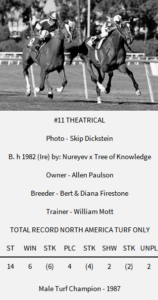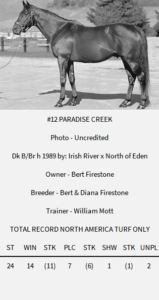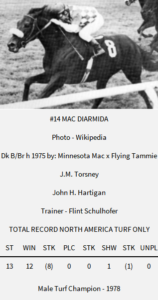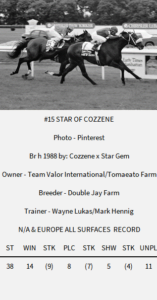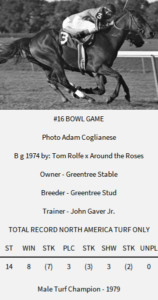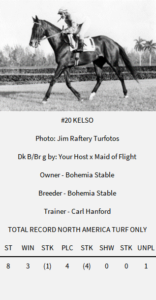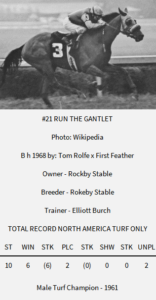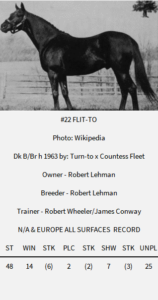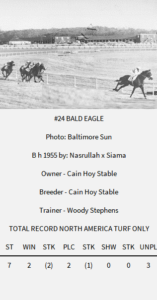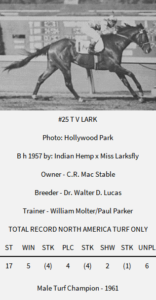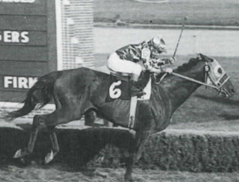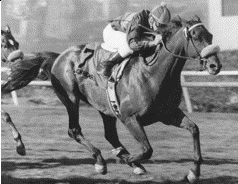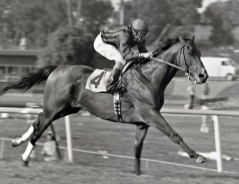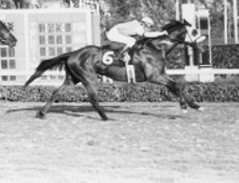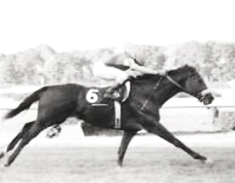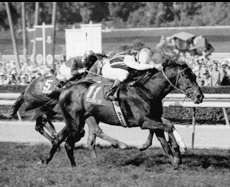
In 1981, John Henry (1A) came from fifth place at the top of the stretch to catch The Bart in the final strides and win the inaugural running of the Arlington Million by a nose. (PHOTO: Jim Bourdier Associated Press)
By: Walter Lazary /// January, 2024
America’s Best Turf Males in the 20th Century
In the first half of the twentieth century, turf racing in North America was virtually unheard of even though many horses bred here during that time were sired by stallions imported from England and France, such turf specialists as Nasrullah, Princequillo, Bull Dog, Sir Gallahad, Blenheim II, and Mahmoud, etc.
In 1950, the Daily Racing Form Manual recognized 103 different race tracks, and every one of them conducted racing on dirt while only nine (an increase from five in 1945) conducted turf racing. These tracks were Arlington Park, Atlantic City, Bel Air, Hamilton (Ontario, Canada), Hawthorne, Hialeah, Monmouth Park, Suffolk Downs, and Washington Park. As incredible as it may seem, there was no turf racing in New York, California, or Kentucky. Ironically, these states, along with Maryland, New Jersey, Florida, and Illinois, would eventually become the mecca of turf racing as we know it today.
Although it was inevitable that turf racing would eventually become popular in America, one man can be given credit for kickstarting its growth: John Shapiro, the president of Laurel Race Course in Maryland. Laurel, which conducted its first race meet in 1911, added a turf course in 1951. It was a bold venture, especially since those who bet on the races had little experience in handicapping races on the turf. As for the horsemen themselves, many were reluctant to train horses to run on the green stuff, which at the time offered them limited opportunities to enter their horses in a race, especially a stake race. Back then, those tracks that did run races on turf often limited it to a single race per day and it could take several weeks before a race came up that met the conditions that would allow trainers to enter a horse that fit them. And stake race opportunities were rare. Of the 571 stake races offered in North America in 1950, only eight were on the turf (three others had been discontinued the year before), and they were usually open races for three-year-olds and up.
But Mr. Shapiro had a vision, and to satisfy that vision, he decided to create an international race that would attract horses from Europe and Australia. The race was the Washington D.C. International, a mile-and-one-half event for a purse of $50,000, the horses that would contend by invitation only. The first International drew horses from England (Wilwyn and Zucchero), Germany (Nierderlander), and Canada (Indian Hemp, an English bred who never stepped foot on Canadian soil but was owned by Canadian Industrialist Max Bell). Their American opponents were Greek Ship, Ruhe, and Pilaster.
Even though the American horses were heavily favored, England’s Wilwyn was an easy winner over Ruhe as both horses came from far back to pass the early leader, Greek Ship, who was ridden by Eddie Arcaro. In reality, America may have lost the race, but it was also a winner as a record crowd of 26,014 came to watch, and they opened their wallets and bet $1,284,786 on the eight-race card, another Laurel record.
The first D.C. International was a resounding success. The race gained momentum throughout the 1950s and 1960s and had a reputation for drawing some of the best turf horses in the world, both internationally as well as domestically. It also spawned two other great turf races, both of which are still contested today: the United Nations Handicap, to be run at Atlantic City beginning in 1953, and the Man o’ War Stakes, to be run on Aqueduct’s new turf course in 1959.
And with this sudden popularity in turf racing, a new star of the turf emerged, one that you might say was hidden in plain sight. Round Table was already a star when racing on dirt, victorious against the likes of Bold Ruler, Gallant Man, Sword Dancer, and Hillsdale. In fact, 50 of his 66 starts would be on dirt tracks, but as good as he was on the traditional American surface, he was exceptional on turf, winning 14 of his 16 starts with a second-place finish when he failed to give catch Clem in the 1958 U.N. Handicap, losing it by a diminishing half-length while toting 130 pounds, which was 17 more than the winner carried. And in Round Table’s other loss, he was injured and finished last, the injury keeping him out of action for nearly four months.
As turf racing continued to evolve through the latter half of the twentieth century, we saw new stars emerge, some of which were equally as good while racing on dirt, while others who couldn’t handle dirt would go on to be highly successful on turf.
Following is HorseRacing20thCentury99.com’s top 25 list of the best male horses to run on turf in North America in the last century. For international runners to be eligible, they must have competed at least two times on turf in North America. Please give it a look and see what you think.
Top Ten Turf Males
Below, are photos of each of HorseRacing20thCentury99.com’s top ten male horses that competed on turf in the twentieth century. Tap ON EACH to go to their profile pages.
#1 – Round Table
#2 – Secretariat
#3 – John Henry
#4 – Lure
#5 – Manila
#6 – Dr. Fager
#7 – Mongo
#8 – Fort Marcy
#9 – Hawaii
#10 – Kotashaan
Best 11 through 25
Tap on image for slide presentation in LIGHTBOX:
